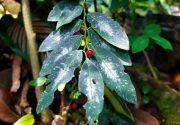Katuk Plant Series (1): A Brief Introduction
"Katuk leaves are commonly consumed locally in Indonesia as vegetables. This plant is often found in the garden or lives wild. The tree is 2-3 m high; the leaves are oval and arranged alternately on one stalk. The flower is small, dark to yellowish in color with red spots that produce black seeds on each branch under the leaves. "Published by : administrator - 30/05/2020 18:42 WIB
3 Minutes read.
Katuk (Sauropus androgynus L.) is a member of the Euphorbiaceae family. Katuk leaves are widely grown in various regions in India, Malaysia and in Indonesia. Another term for katuk varies from region to region. Among them, memata (Malay), simani (Minangkabau), kebing and katuk (Javanese), kerakur (Madura), katu (Sundanese). Katuk is also known as star gooseberry or sweet leave in English. There are two types of katuk, namely red katuk and green katuk. The red katuk live freely in the jungle of Indonesia, meanwhile, the green katuk coexist with other types of vegetable plants. Katuk is also an ornamental plant. In addition to being used as vegetables and ornamental plants, green katuk is also used as medicine.

Image source: www.harianmerapi.com
Katuk content includes protein, fat, calcium, phosphorus, iron, vitamins A, B and C. The vitamin C in katuk is much higher than oranges and guava, which we know are very good source of vitamin C. Vitamin C is the body’s main compound in various important processes. In addition, katuk is also known as a good source of vitamin A. Vitamin A also plays an important role in the body, such as curing eye diseases, cell growth, the immune system and maintaining healthy skin.
Katuk has high calcium levels. Consuming katuk leaves, indirectly, can also meet the calcium needs in the body so that it can prevent bone fragility and osteoporosis at an early age. Katuk chlorophyll content functions to clean body tissues and a place for disposal of metabolic waste, as well as overcoming parasites, bacteria and viruses in the body.
Katuk leaves contain polyphenols and steroids that play a role in the prolactin reflex or stimulate the alveoli to produce mil, and stimulate the oxytocin hormone to trigger the release and flow of breast milk.
Sources:
Elshabrina. 2018. 33 Daun Dahsyat Tumpas Berbagai Macam Penyakit. Yogyakarta: C-klik Media
Tilaar, Martha. 2010. The Green Science of Jamu: Pendekatan Pragmatik untuk Kecantikan dan Kesehatan. Jakarta: Penerbit Dian Rakyat
Wikipedia (diakses pada tanggal 03 Februari 2019)
ARTIKEL BERKAITAN:
Daun Katuk, Sahabat Ibu Menyusui
Cara Mudah Menanam Tanaman Katuk Sendiri di Rumah
5 Variasi Resep Makanan Daun Katuk Lezat, Asupan ASI Booster – Bobor Katuk Podomoro
5 Variasi Resep Makanan Daun Katuk Lezat, Asupan ASI Booster – Sayur Bening Katuk Jagung Manis
5 Variasi Resep Makanan Daun Katuk Lezat, Asupan ASI Booster – Rolade Daun Katuk
5 Variasi Resep Makanan Daun Katuk Lezat, Asupan ASI Booster – Kue Daun Katuk










